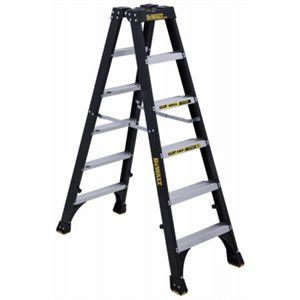- ,
Ladders are made from three basic materials:

Fiberglass

Aluminum

Wood
From extension ladders that can serve a wide variety of purposes to attic ladders that are made for a specific use, choosing the right ladder for your needs can be daunting without knowing where to start with your decision making process.

Step Ladder

Step Stool
Step ladders range in size from 3-feet to 20-feet in length along the side rail. Step ladders shorter than 3-feet are considered step stools.
Before you use a ladder, carefully check for power lines. Keep all ladders at least 10 feet from any power lines. And remember, wood and aluminum ladders conduct electricity, so fiberglass ladders are the best choice, but even they are no guarantee of safety when working near power lines.
For use on uneven surfaces that need adjusting, TrueValue.com offers a variety of ladder accessories such as: stabilizers, levelers, and mitts to aid in reducing the risk of injury.
According to OSHA laws, any obstruction behind the ladder shall be 7 inches (18 cm), except in the case of an elevator pit ladder for which a minimum perpendicular clearance of 4 1/2 inches (11 cm) is required.
Using a ladder that is too long or too short increases the likelihood of losing your balance and injury. A ladder is too long for the project if it extends more than three feet beyond the upper support point. It is also important to remember that the top three rungs are not to be used for climbing..

Extension Ladder

Step Ladder
A ladder is too short if you must stand on or above the first step from the top of a step ladder, or the third rung from the top of an extension ladder.

Multi-Position Ladder
Multi-position ladders can be a great addition to your set of tools. Some multi-position ladders, like articulating ladders, can be set up in several configurations making them a flexible option for many types of projects.
This is the maximum weight capacity the ladder can carry. According to the American Ladder Institute, you should factor in the following when considering the weight needed for your ladder:
Your weight + the weight of your clothing & protective equipment + the weight of your tools & supplies you are carrying + the weight of tools and supplies stored on the ladder
There are five categories of ladder Duty Ratings:
All Duty Ratings can be found on a sticker placed on the side of the ladder. A longer ladder does not mean a higher weight capacity. Never exceed a ladder’s maximum load limit.
We hope this ladder buying guide simplifies the process of choosing the right ladder for your needs and project.
Get offers and project ideas
Our True Value stores are independently owned and operated. Enter your City & State or zip code to see stores near you.
You can use the format: [City, State] or [zip code]